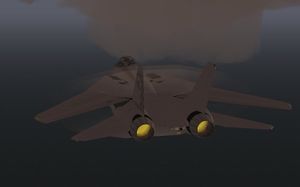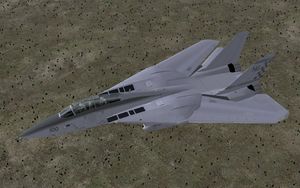Understanding Supersonic Flight
Thorsten
Status: Nov. 24th, 2009
Quite a few aircraft in FlightGear are capable of supersonic flight. For some of them, notably modern fighter aircraft, supersonic flight does not require any specific action by the pilot. Nevertheless, it may be useful to understand why the aircraft behaves somewhat different when the speed of sound is approached. For other aircraft, such as the Concorde or the SR-71 Blackbird, operating the aircraft in supersonic flight means following elaborate climb-out procedures, the necessity of which is difficult to appreciate without any background knowledge.
Disclaimer: Like the vast majority of pilots, I have never operated a real supersonic aircraft myself, so the information presented here is based on aerodynamics, operating manuals of supersonic aircraft and simulated flights. All test flights have been made with v1.9.1.
The Speed of Sound
The speed of sound in a medium is the velocity at which the information of a local disturbance can propagate through the rest of the medium. Sound waves in air are compression waves, i.e. zones of higher air pressure alternating with zones of lower air pressure. Thus, the value of the speed of sound in air is set by its compressibility, i.e. the resistance a volume of air exerts when it is compressed to a smaller volume. This in turn depends almost exclusively on the air temperature (although there is a small effect due to air pressure and humidity on the order of a few % as well).
This has consequences for aviation: Since the ambient air temperature drops when an aircraft climbs to higher altitude, the speed of sound changes as well. While the speed of sound is about 661 kt at sea level, it drops to ~570 kt at the typical cruising altitude of airliners (30.000 ft). The Mach number, i.e. the ratio of the airspeed of the plane to the speed of sound, is often used as a velocity measure. Mach 1 means that the aircraft flies with the speed of sound, Mach 2 indicates that the aircraft moves with twice the speed of sound, and so on. It follows from the above that Mach 2 at sea level is quite a bit faster than Mach 2 at 30.000 ft altitude.
The speed of sound is a critical velocity in aerodynamic considerations: Every aircraft displaces air while in flight - this is what causes a drag force that slows the aircraft down when not compensated by engine thrust. The displacement of air is a disturbance of the equilibrium in the atmosphere. For an aircraft in subsonic flight (slower than the speed of sound), the information of this disturbance travels well ahead of the aircraft, and the airstream is already modified in advance of the aircraft, leading to a relatively smooth airflow. For a plane approaching the speed of sound that is no longer true: The information on the disturbance arrives at the same time as the disturbance itself, leading to the creation of a shock wave in which properties of the airflow (like flow velocity and temperature) change rapidly over a small distance. Such shockwaves are highly dissipative phenomena, i.e. a large amount of heat is created by them. The appearance of shockwaves is what changes the aerodynamics quite radically.
Transonic Flight
Effects of shockwaves become apparent well in advance of the aircraft reaching Mach 1 when parts of the airflow around the aircraft become supersonic. This regime, roughly from Mach 0.8 - Mach 1.2, is called the transonic regime. The onset of the transonic regime occurs when some spots on the aircraft start to create supersonic flow and cause shockwaves.
Shockwave creation takes a lot of energy, especially if the shockwave is stationary (i.e. the airstream reaches Mach 1). As a result, the drag on the aircraft may increase quite suddenly in the transonic regime up to a factor four for just a small increase in velocity. This phenomenon is called wave drag. At the same time, propeller efficiency drops significantly when the airstream on the propeller blades becomes transonic. WW II fighter aircraft could reach this regime in dives, but their engines were nowhere powerful enough to cope with the increased drag, nor were they designed to withstand the additional stresses. As a result, their flight became unstable and for a time it was believed that the difficulties could not be overcome - the term sound barrier was coined.
However, it soon appeared that jet engines do not suffer from the same efficiency losses as propellers, and that a suitable aircraft design could significantly reduce wavedrag. Aircraft based on the Whitcomb area rule were shown to have minimal wave drag. This rule states that going from the nose to the tail along the longitudinal axis of the aircraft, the variation in cross section area of the aircraft should be as smooth as possible. This rule led so somewhat funny-looking early designs - the onset of the wings (increasing cross section) for example had to be offset by a 'wasp-waisting', leading to a Coke-bottle shaped fuselage as seen in the F-106 Delta Dart or the Blackburn Buccaneer. Sometimes, so-called anti-shock bodies had to be added to an aircraft to increase the cross section area in order to reduce wave drag. Modern designs however incorporate the area rule in a much more streamlined way. Even airliners which operate in the low transonic regime (Mach 0.85) show characteristic design features of the area rule.
Nevertheless, the transonic flight regime is in all aircraft characterized by the sudden increase in drag which needs to be overcome somehow. Modern fighter craft usually utilize the increased thrust of afterburners to accelerate through the transonic regime quickly.
Under the right conditions, the supersonic part of the airstream can leave characteristic vapour clouds caused by a phenomenon called Prantl-Glauert singularity. This looks rather impressive and is actually modelled in Flightgear (see picture).
Supersonic Flight
Out of the transonic regime, wavedrag is reduced significantly. The reason is that shockwaves are not stationary any more, they are continuously displaced and pushed aside by the aircraft which is now moving faster than the shockwave. While aircraft accelerate very slowly through the transonic regime, as soon as true supersonic flight is reached, the acceleration increases.
This has given rise to the concept of supercruising - sustained supersonic flight in a low wave-drag regime, typically without the use of afterburners, as afterburners are very fuel-consuming and normally cannot be used for sustained flight (the exception are the engines of the SR-71 Blackbird which are designed for continuous use of afterburners).
The ability to supercruise comes with its own problems: First, jet engines need a subsonic airstream in the intake. For an aircraft flying at Mach 2, it is not easy to get a subsonic airstream into the engines, and so engines designed for supersonic use do not usually perform well at subsonic velocities and vice versa. Second, the shockave of the aircraft generates a lot of heat, so the fuselage needs to be heat-resistant. Third, supercruising usually means high-altitude flight, as the density of air (and hence the overall drag) is much reduced, therefore the aircraft needs a life-support system. For example, the Concorde cruises with Mach 2.2 at 52.000 ft and the SR-71 takes it even higher by cruising with Mach 3.2 at 80.000 ft.
Experiencing supersonic flight in Flightgear
Supersonic aircraft fall in two classes: Those capable of supersonic flight for a short time are usually fighters with high thrust engines, but these do not operate efficiently in the supersonic and as a result the aircraft cannot easily sustain their peak velocities. Examples for this in Flightgear are the English Electric Lightning or the F-14b Tomcat. Very few aircraft can sustain supersonic flight, and as a rule they are difficult to fly to their operating altitude and velocity. Examples in Flightgear are the Concorde or the SR-71 Blackbird.
Mach 2 with the Lightning
Possibly the easiest plane to reach supersonic flight is the English Electric Lightning. This plane has a thrust/weight ratio of 1.2, i.e. it acts more like a rocket than an airplane. In level flight, simply accelerating with full throttle will bring you to Mach 2 without any fuss, and you can watch the scenery rushing by. You can also watch your fuel gauges drop - the fuel consumption of the engines at full thrust is rather impressive.
Supercruising the Tomcat
The F-14b has the ability to supercruise in the high transonic regime. In level flight, accelerate with full afterburner thrust. Around 500 kt, the increase in velocity is very slow, but above 600 kt when the wings sweep back, the velocity starts to increase much more rapidly as the wavedrag decreases, and you can actually remove the afterburner and cruise the plane with military thrust between 700 and 800 kt quite efficiently.
Mach 3 with the Blackbird
One of the most interesting experiences in supersonic flight is to get the SR-71 Blackbird to its cruising altitude and speed. This is not as easy as it looks - the Blackbird's engine on full afterburner thrust sure look very impressive, but the thrust/weight ratio is actually a mere 0.38, far below the capabilites of the Lightning, and the engine reaches full efficiency only above Mach 3. This explains the peculiar procedure used to bring the Blackbird up to speed: The engine is strong enough to climb to 33.000 ft and Mach 0.99, but not strong enough to continue acceleration and climb for large wavedrag. So, more thrust or less drag would be needed to penetrate the transonic region. If the airplane would move faster, then the engine would be more efficient and provide more thrust - but it doesn't. If the airplane would fly higher, drag would be reduced along with the air density - but it can't climb much further because the reduced drag also means reduced lift, so the plane would need to move faster - but it doesn't.
The solution is to use gravity's help to go through the transonic regime in a shallow descent, and then, when the wavedrag is reduced again and the engine thrust is sufficient to accelerate on its own, to climb back out again. The subsequent climb to 80.000 ft needs to be carefully managed as well (basically the pilot flies with a constant EAS (equivalent airspeed) of 450 kt). The complicated climbing procedure of the Concorde to cruise altitude is dictated by similar considerations.
Warbirds and the sound barrier
As of Flightgear 1.9.1, the transonic regime does not seem to be modelled for WW II fighter aircraft. Steep test dives with several planes indicated that the planes behaved well in supersonic flight at sea level without any of the problems that would actually occur in real aircraft.

